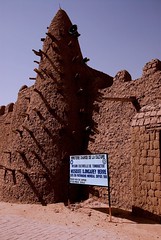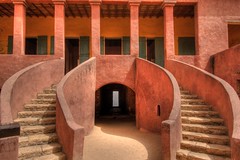We have all long heard the saying that something we desired is “as far away as Timbuktu”. In many western cultures the ancient city of Timbuktu is used as a metaphor to signify the distance one was trying to overcome to attain some goal or objective. Many people do not even believe Timbuktu is a real city but rather, like Shangri-La, some mythical place, as far removed from our existence as the moon or Mars.
However, as I recently discovered, Timbuktu is not that far away. By air it is only 45 minutes from Mopti, the same time necessary to fly from Chicago, Illinois to Dayton, Ohio. By motor vehicle Timbuktu is a scant four hours from Mopti, less than the time it would take one to drive from Phoenix, Arizona to San Diego, California.
Located on the edge of the Sahara desert in Mali, West Africa, Timbuktu has been a cultural, educational, religious, and trade center for approximately two thousand years. A Tuareg herdswoman named Buktu discovered an oasis in the Sahara almost two thousand years ago that she used as a camp during the dry season for her herds and flocks. Soon she set up a permanent camp and dug a well, hence the name Timbuktu, or, Buktu’s well.
Timbuktu soon became a stop on the trans-Sahara trade route for travelers, nomads, and caravans. Merchants setting up markets and building fixed dwellings instead of the usual tents really established Timbuktu as a meeting and trade location.
The kingdom of Ghana, the first great empire of the region, organized and controlled the trade of gold, salt, slaves, and other commodities in the area. Large caravans of camels laden with salt came to Timbuktu, where merchants shipped the goods along the Niger river to other African towns in exchange for other goods., most notably gold. It was this gold that Arab merchants told European traders about that later led to the trans-Atlantic slave trade.
Eventually Timbuktu came under the control of the Mali empire, the second great empire in West Africa and the first great Muslim kingdom in the region. These same trade routes, over which gold, salt, slaves and koala nuts were transported, also brought scholars and settlers who introduced Islam to the region.
The Malian king Mansa Mousa built magnificent mosques throughout his empire to spread the influence of Islam. Mousa transformed Timbuktu not only into one of the major cultural centers of Africa but the Islamic world. Timbuktu grew in wealth and power and became a meeting place for poets, scholars, and artists from Africa and the Middle East. In 1324 Mousa took a pilgrimage to Mecca and brought Timbuktu to the attention of the rest of the world.
The Djingarey Berre Mosque was built under Mousa’s leadership. Its mud and brick construction started a 600 year tradition that remains today. Djingarey Berre dominates Timbuktu to this day and has space for 2000 worshippers. Mali lost control over Timbuktu and its environs in the 15th century but Timbuktu was still the major Islamic center of sub-Saharan Africa.
In 1468 Timbuktu came under the control of the Songhay Empire. The city went through a golden age with doctors, scholars, judges, and clerics contributing to a culture where books became one of the leading commodities in the city. Theology, rhetoric, Islamic law and literature were taught at the Sankore University, which was housed in the Sankore mosque.
In 1590, Morocco, desiring the gold flowing from the Songhay, conquered Songhay and destroyed the empire. This development, along with the growing Atlantic Ocean trade routes, led to a serious decline of Timbuktu. Moroccans ruled Timbuktu until approximately 1780. Various bands, including Tuaregs and the Bambara kingdom in Segou, took over Timbuktu until the 19th century, when the French took control of the city.
Due to Timbuktu’s reputation as an unreachable city, vast and inhospitable but covered with gold, the French offered a substantial amount of money to any European explorer to reach the city. A young Frenchman named Rene Caillie took up the challenge and, disguised as an Arab, reached Timbuktu in 1828. What Caillie found was a barren, desolate town with no trace of the wealth the French had long heard about. The gold trade had moved to the West African coast and was largely replaced by a more lucrative trade in slaves.
Modern day Timbuktu gives an appearance of being as desolate as the town Caillie reached in 1828. It is fighting encroachment from the Sahara Desert and its water and vegetation has been stripped away by desertification. However, its mosques and libraries, both public and private, still exist. Its citizens depend largely on tourism and it has three hotels for travelers to rest in. Timbuktu’s teenagers look like teenagers from any other western town in dress and clothing styles. The four wheel drive Toyotas and Nissans that travel its sandy streets have to make space for the occasional burro and cart traveling those same roadways. Its people are friendly and its hotels comfortable, if not spartan. An internet café exists in Timbuktu and if you have the right cell phone provider you can telephone anywhere in the world.
Click on the photograph to see more photographs from Timbuktu
Happy new year
6 years ago






